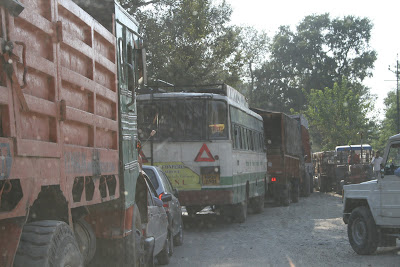Pingalwara
This was a remarkable place, and the story behind it is even more compelling. Pingalwara's formation was sparked in 1934 by Bhagat Puran Singh Ji in Amritsar, Punjab.
A Surprisingly Arduous Journey Our journey from Dharamsala to Amritsar was absolute madness. The traffic congestion, road closures, detours, and holiday celebrations in honor of Baba Buddha (1506-1631) made traveling quite arduous.
Our journey from Dharamsala to Amritsar was absolute madness. The traffic congestion, road closures, detours, and holiday celebrations in honor of Baba Buddha (1506-1631) made traveling quite arduous. 
As we finally entered the Amritsar district, I could feel the frustration in the air as traffic turned into a constant stop-and-go rhythm. Each time we halted, I noticed a group of Sikh boys eagerly jumping onto our jeep, ready to clean it and enthusiastically offer beverages. It seemed almost normal to me, but since most of the team members have never traveled in this manner, their reaction was funny. Some thought we were being overwhelmed or even attacked. I took a moment to reassure them, explaining that the holiday was a time for celebration, and the local people were simply expressing their hospitality by cleaning vehicles and offering drinks to travelers along the busy roads. They were not begging or asking for handouts, nor trying to harm us. 
We left Dharamsala in the early afternoon but did not reach Amritsar until about 8 PM. Our new drivers were not very skilled, and we really missed our Punjabi-speaking Tibetan drivers. Once we arrived in Amritsar, Tom and his other guide, Hekani, arranged for us to stay at a guest house that was unsettling and rather creepy for most of the team. Some team members refused to stay there, so we opted for the "Ritz Plaza". I wasn’t thrilled about it, but it was the best option we had at that point of the night. It had been an overwhelming day of travel for the team so having a place to stay for the night provided a sense of calm.
The government of Punjab needs to consider improving the conditions of their roads and highways, along with more practical design and infrastructure. Perhaps they could entertain proposals from experts in engineering and architecture as a starting point for much-needed reform and restructuring.
The highlight of our visit to Amritsar was undoubtedly Harimandar Sahib, known as the Sikh Golden Temple to many westerners. Its architectural beauty and serene ambiance left a lasting impression on all of us. Sitting by the water's edge near the Gurudwara instilled a deep sense of peace. I sincerely hope that the administrators continue to uphold its beauty and protect it from any deterioration, as it is a cherished sanctuary for so many. 

Education in Dharamsala

We were fortunate enough to interview directors of various Tibetan schools, nunneries and the Transit School. When Tibetan refugees arrive in India, they are transported to the refugee center. They await their rare meeting and personal blessing from His Holiness the Dalai Lama.
After the blessing, younger refugees are placed in the Sherub Gatsel Lobling School (Tibetan Transit School) where they have the option to remain for up to five years. The school has approximately 700 students. There they are taught a trade, language skills, technical training and education along with food and board. These young refugees have the option to stay the five years or leave earlier. After their time at the Transit School, either they go to a regular school, begin working, or are placed in one of the many Tibetan centers all over India. Some go back to Tibet so that the Tibetan culture is preserved and the aim of independence is never forgotten. I was impressed with their organization and outreach to the International community.
We interviewed the Director of a Tibetan and Indian school in Dharamsala who is a very excited about the work he does with the schools. Because the school is a mix of Tibetan and Indian students, he stressed ongoing cultural exchanges during childhood. This ensures a mutual understanding between ethnic Indians and the Tibetans. He told us the Indian government has been good to the Tibetans and allowed them to freely live in Dharamsala, while allowing them to preserve their culture...in many ways better than in Tibet. His Holiness the Dalai Lama has aided his people well, and people all over have been generous to the Tibetans out of care and concern. 

School children taking a break at the Tibetan cultural festival. Tibetan school girls out for a walk.
Dining hall for primary school children
My research has led me to the understanding that the schools in Dharamsala are largely in satisfactory condition and are undergoing continuous improvements and modernization efforts. It is encouraging to note that Tibetan schools and the newly established villages in the region benefit from significant support through international philanthropic initiatives. Funding is also provided by esteemed organizations such as the Dalai Lama Foundation, the Tibet Administration, and various governmental programs.
Many Tibetan schools face pressing issues such as the need for enhanced building structures, better quality benches, softer mattresses, and more nutritious food options.
The strategies employed by the Tibetan government in exile to develop, maintain, and modernize their educational system can serve as a valuable reference for Indian states that have struggled to achieve similar advancements in their public schools and are working towards enhancing their public education infrastructure. This collaborative spirit may pave the way for future improvements in schooling across the region. It was very inspirational to observe many of these schools in Dharamsala. unable to do the same for their own schools. 
Kids in their music class excited to see us! Tibetan girl dressed for her art and music class.
Tibetan girl dressed for her art and music class.
